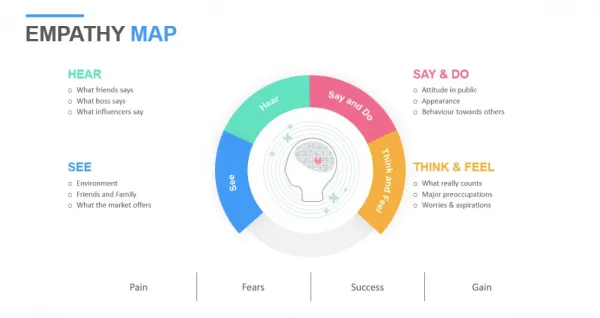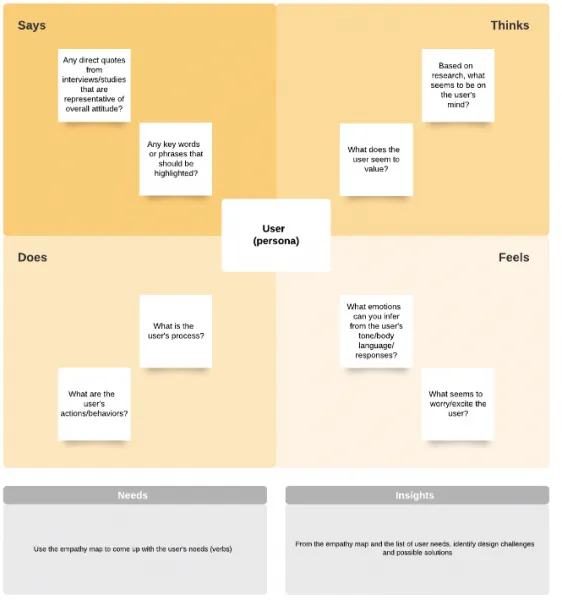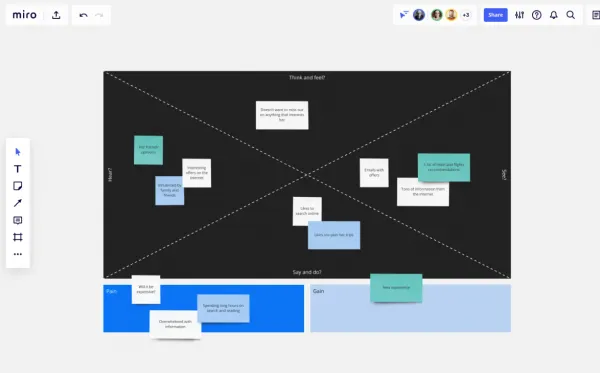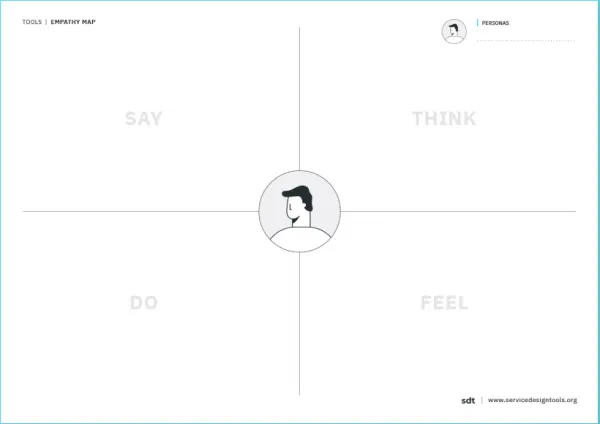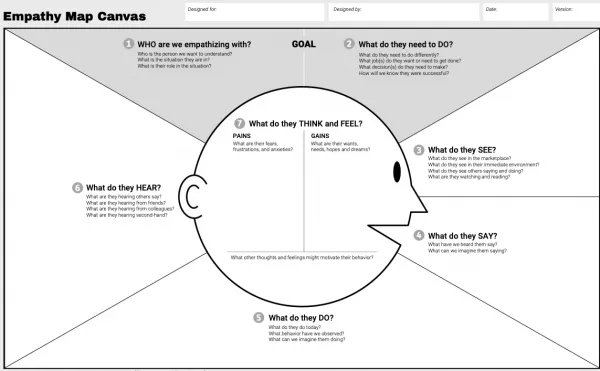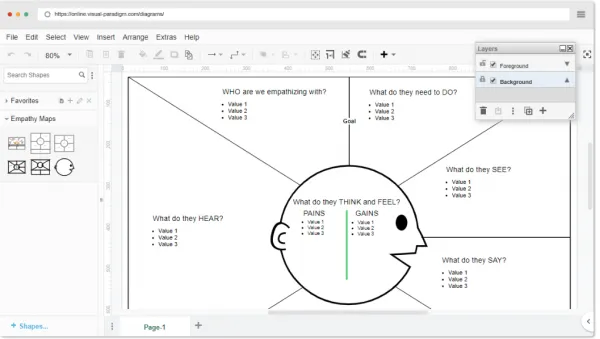
An empathy map is a simple diagram summarising information about a user’s actions and emotions. It is a helpful tool that enables teams to comprehend their users fully.
To create empathy for end users, stakeholders, marketing and sales, product development, or creative teams might participate in a simple workshop exercise called empathy mapping. An empathy mapping exercise is an excellent way for teams working on designing and engineering goods, services, or user experiences to “get inside the heads” of people.
Empathy Map in Design Thinking
These maps should be utilized throughout UX processes to help team members find common ground and identify and prioritize user needs. They are most effective when used early in the user-centered design process. The following reasons highlight the significance of using this map:
It Captures the Identity of a User or Persona.
The empathy-mapping technique aids in distilling and categorizing your knowledge about the user into a single location. It may be used to:
- Categorize and make sense of qualitative research (research notes, survey responses, and user-interview transcripts).
- Identify gaps in your present knowledge and the research required to fill them. A limited map suggests that additional study is needed.
- Develop personas by aligning and organizing empathy maps covering specific users.
Describes a User or Personality to Others:
Empathy mapping is a simple, easy-to-understand technique to depict user attitudes and actions. Once produced, it should serve as a source of truth for the project’s duration, shielding it from prejudice or erroneous assumptions. Keep your empathy “alive” by reviewing and changing them as you conduct further research.
It Collects Data From the User Directly
When users directly fill in empathy maps, they can serve as a supplemental data source and a beginning point for a summary of the user session. Furthermore, the interviewer may elicit sensations and ideas from the interviewee that would otherwise be concealed.
How to Create an Empathy Map?
Making this map is a simple process that may be accomplished using an online whiteboard. You may use a pre-made template or create one from scratch to incorporate the precise facts you need to evaluate. In either case, most of these maps will provide the same quadrant of details.
A conventional map consists of four quadrants. Does, Thinks, Says, and Feels are the four verbs. These quadrants pose specific questions on examining the user’s point of view and what they achieve in their everyday activities. These quadrants can follow any order as long as they all consider each other :

User
Before diving into the quadrants, you must construct your primary user or user persona. This will be the fundamental assumption from which you will begin studying the map. Your team must agree on who will be included in this section and how you’ll meet their demands. After creating a user persona, you will begin studying the prompts through their eyes.
Remember to keep your attention on them to expose their reasons and sentiments. As you flesh out your user persona, consider the following questions to assist your progress and narrow down the user you’ll be concentrating on:
- Will your user play a specific role in a particular field?
- Will they be a specific customer?
- How does their user persona appear?
Define
Who is the person for the map?
The first step is identifying the person you want to map, understand, and empathize with. It is essential to use different maps for each individual.
The objective of Empathy mapping
You anticipate the user will act in this way. What does achievement entail? What, for instance, must he or she decide or do differently? Answering this question helps participants concentrate and provide the context for the activity, even if the exercise is about developing empathy rather than marketing or designing something.
Research
The most accurate empathy maps come from actual data. Assemble the results of qualitative research projects, diary investigations, or user interviews. Once the essential data has been gathered, request that each team member who will participate in empathy mapping read the research before the session. You can start the mapping process once everyone on the team is acquainted with the study data.
Observe
Examine the user’s experience first, then try to put yourself in the user’s shoes. Fill in the blanks on the map to record what the user sees, says, does, and hears.
What does the user SEE?
What is the user running into daily? These could be items, people, or their actions. What are those in the user’s immediate area doing? What does the user see, read, and encounter in his/her surroundings or the workplace that might impact the user? Think about substitute goods and services or what the rivals are doing. Remember that this is the user’s world, not yours, and you shouldn’t presume that the user is focused on your business or goods.
What does the user HEAR?
What does the user hear, and how is it affecting them? Take into account the user’s relationships with friends, family, and coworkers, in addition to the media’s reporting on bloggers, social media influencers, and subject-matter experts. Concentrate on issues that affect the user’s thinking rather than irrelevant information streams. Influencers should concentrate on the people, things, or locations affecting user behavior.
What does the user DO and SAY?
What actions and conduct do the user exhibit? What does the user say, and what is their attitude? Depending on the user’s location, companions, and surroundings, this might alter. An individual’s actions or communication style might convey their attitude. If applicable, note any recent changes to a user’s behavior or differences between behavior in public and private settings.
Download template Empathy Map | Service Design Tools
Investigate
After the external components are finished, the attention shifts within the mind to investigate the user’s private, invisible thoughts and feelings. These could be hypothesized, estimated, or recorded in direct quotes during the study. The goal of the exercise is for teams to picture what it might be like to live in someone else’s head.
What does the user THINK and FEEL?
What matters to the user that they are considering it? Think about both the good and negative thoughts. What causes the user to feel happy or unhappy? What worries the user, and what keeps them awake at night? As the user considers doing or trying something, their mind investigates options and paths. What is the user’s mood? Frightened? Excited? Anxious?
Next, examine the unique user benefits and pains. What are the signs of success and failure? Identify the problems and challenges that the user faces, including any roadblocks. What aspirations does the user harbor? Gains are what a user hopes to obtain or possess.
Summarize
After finishing all the portions, take a moment to think. Invite participants to talk about their impressions of the event. Inquire about how it affected their viewpoints or if it led to any discoveries. Note any findings and concepts the group came up with.
When to Use an Empathy Map
This map extends beyond your customers’ hobbies, abilities, or lifestyles to what they see, feel, and think, giving you a better grasp of what it’s like to be them. As the name suggests, it helps you empathize with the consumer or client.
You may also utilize it to connect with your ideal consumer or different audience groups. When you apply it to the highlighted circumstances, it will help you achieve your goals:
Creating a Business Model
Starting your business model with empathy mapping allows you to investigate your ideal client’s needs and pain points and how you may supply a solution to an existing problem.
Product Creation
Empathy may be helpful in software development or when building a new product. It assists developers, engineers, and creators in empathizing with individuals who will use your product. Ideally, you should always use this when beginning product development and continue to utilize it as the product matures and expands. The map will become increasingly helpful as you receive input from actual users.
Customer Profiles
Although this is often part of persona building, empathizing may assist team members in adding even more depth to those personas and bringing them closer to resemble real humans.
Employee Training
These maps are highly beneficial for firm employees or team members. As a result, educating them to empathize with customers is critical, primarily if they work in a department that directly interacts with them.
Design Thinking
Design Thinking divides the design process into five stages: empathize, define, ideate, prototype, test, and implement. It is simple to foresee at least one of the stages that are excellent for empathy mapping, the Empathize phase at the beginning. The Test phase is another option. Empathy maps help show feedback from usability assessments.
Online Sales and Marketing Campaign
Marketers and sales representatives may empathize using this map to understand who they’re addressing. Knowing the pain areas of their potential or ideal consumers allows them to employ the appropriate language, tone, and design offers that appeal to these prospects.
Analyze User Behavior
Empathy mapping helps you put yourself in the shoes of your customers and users, figuring out what they notice and think about your product. What do they hear from their colleagues or other people who have used the product? Is there something with the user interface that hinders them from utilizing the product as intended, or are they simply uninterested in some of the features?
Empathy Map vs Persona
Personas and empathy mapping are CX techniques that help you better understand your consumers. Harnessing these capabilities becomes vital as the relevance of highly personalized and even predictive experiences grows across channels. However they both attempt to provide consumer insights and identify pain spots, but the two are commonly confused.
Personas are fictitious consumers designed to represent a more extensive customer group. They also assist you in “keeping the customer in the room” and designing customer-centric CX by providing a clearer image of your primary consumers. Empathy mapping depicts how a consumer feels and behaves. One of the benefits of empathy mapping is its simplicity. Although the results will be considerably more substantial if the responses are research-based, it is feasible to brainstorm an empathy map without such data.
Personas and empathy mapping can create a more comprehensive picture of your clients. Personas tell you who your consumers are, and empathy mapping tells you how those customers feel about your brand. While both are essential components of the CX toolbox, they may be utilized independently or in tandem to provide a comprehensive solution.
Limitations of Empathy Mapping
Every user’s viewpoint is always formed, and a particular personal opinion is incorporated into the map. Taking an active view from the user’s point of view also takes a lot of experience and thought.
While empathy mapping is a low-cost and transmitted method of creating for and catering to the customer, it cannot be used in isolation. To adopt the most accurate knowledge of the user’s perspective, it is critical to locate and use as many user-centered conventions as possible.
FAQs on Empathy Maps
What are the Components of Empathy Mapping?
Empathy Mapping is divided into four quadrants. The four quadrants represent four major characteristics that the user exhibits/possess throughout the observation/research stage. These four quadrants represent what the user said, did, thought, and felt.
Is Empathy Mapping Agile?
It is agile because it may be used to test Agile Project Management (APM).
What Comes First: an Empathy Mapping or Persona?
Personas come first because they are the foundation for understanding who your customers are, and empathy maps reveal their views and actions toward your brand.
What Problems Can Be Solved Using Empathy Maps?
- Fear and mistrust.
- Cognitive and mental biases.
- Undiscovered user requirements, aspirations, and objectives.
- An inadequate grasp of what motivates consumers’ behavior
Shane Drumm, holding certifications in PMP®, PMI-ACP®, CSM, and LPM, is the author behind numerous articles featured here. Hailing from County Cork, Ireland, his expertise lies in implementing Agile methodologies with geographically dispersed teams for software development projects. In his leisure, he dedicates time to web development and Ironman triathlon training. Find out more about Shane on shanedrumm.com and please reach out and connect with Shane on LinkedIn.

